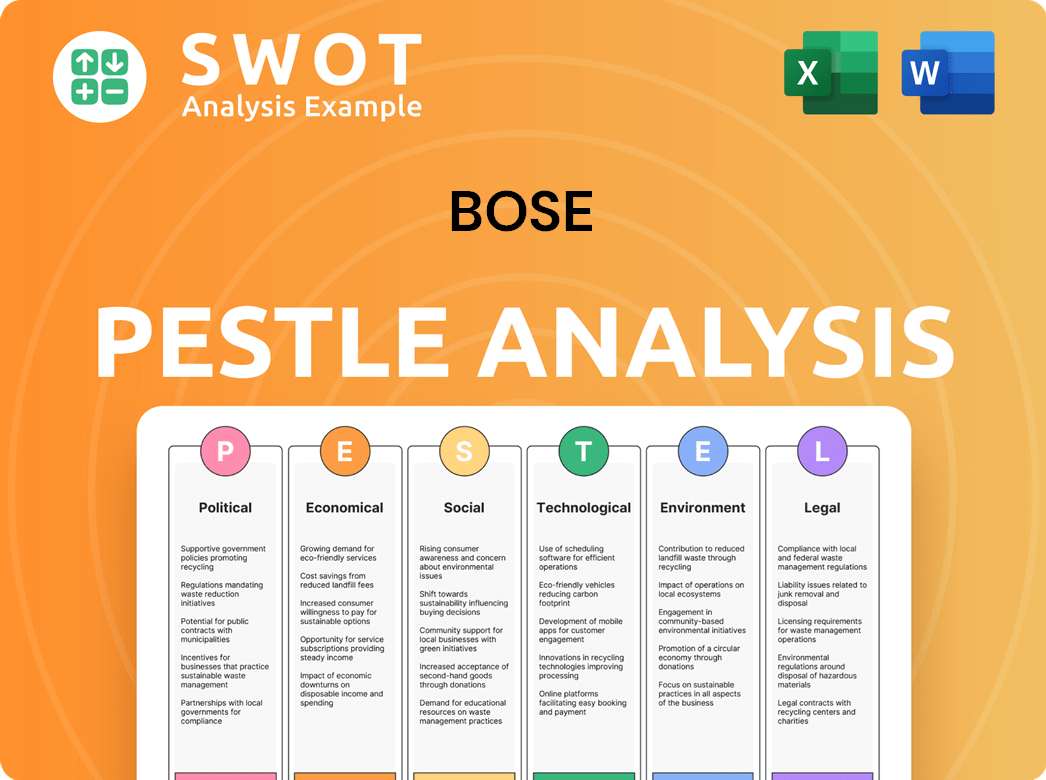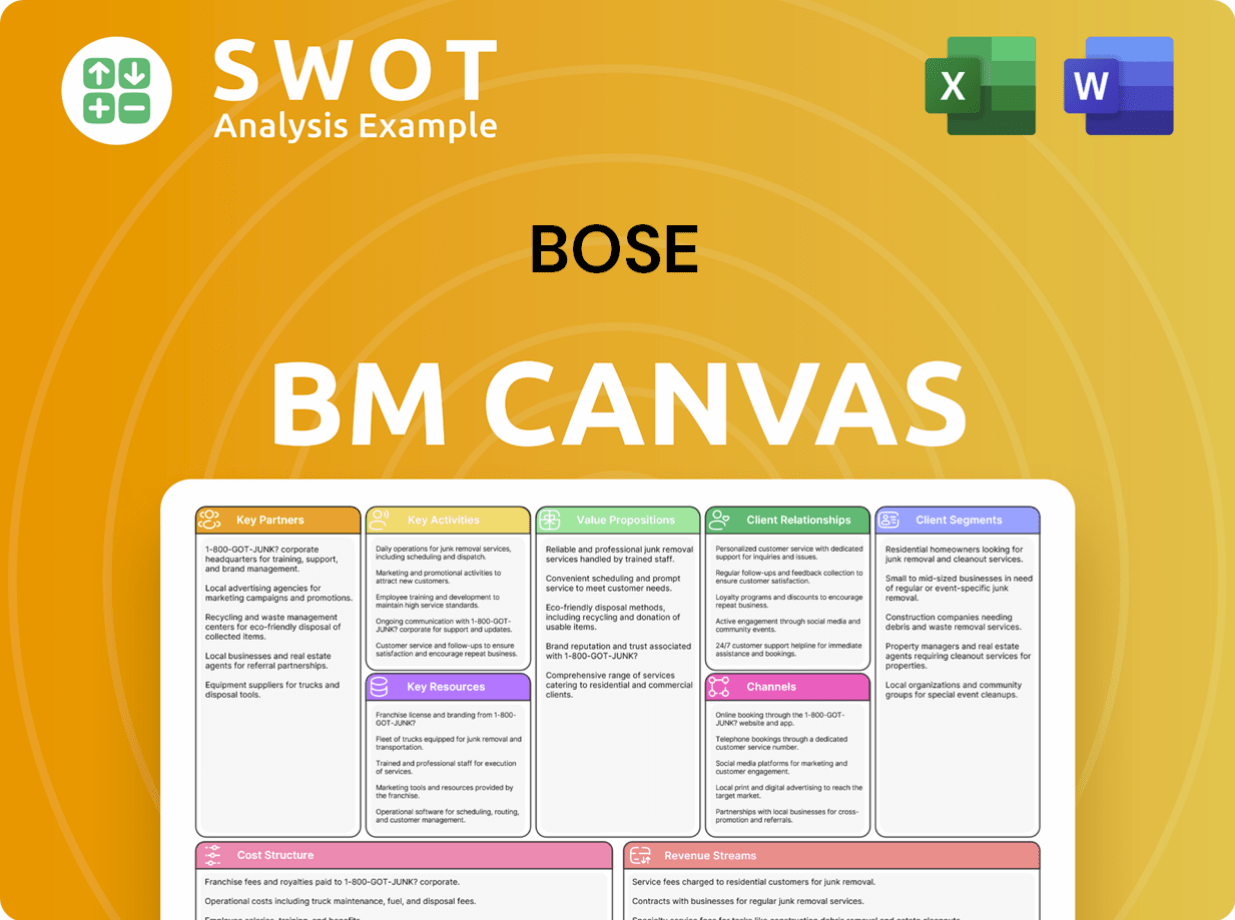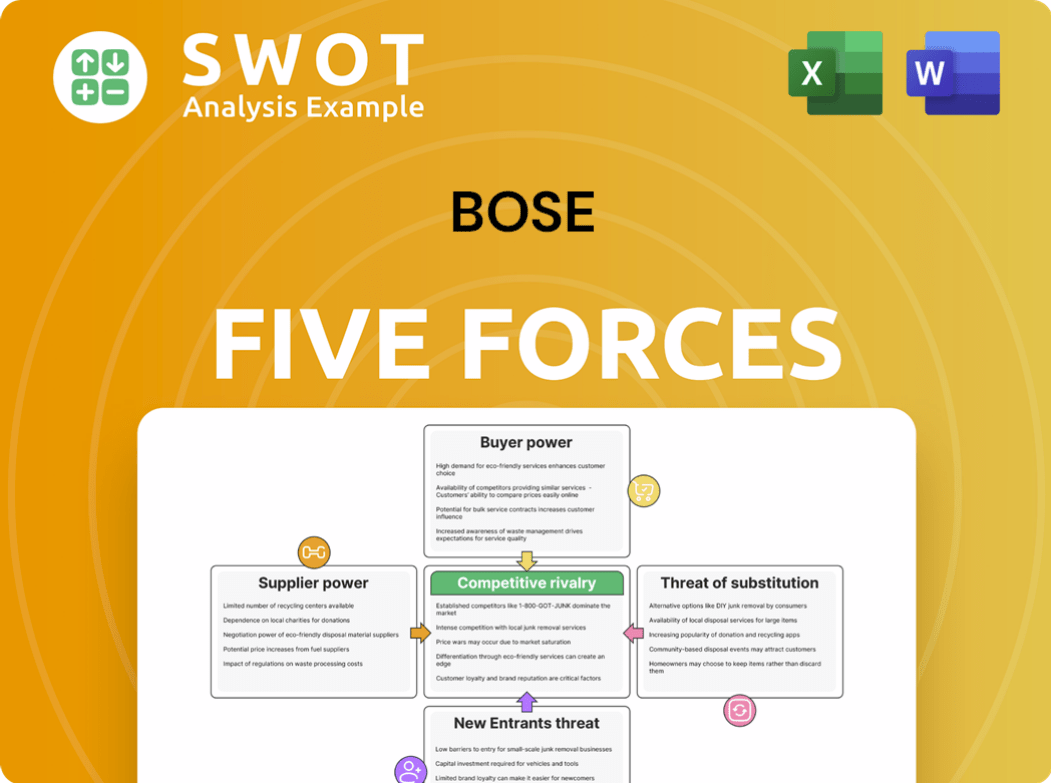Bose Bundle
How Does Bose Dominate the Audio Market?
Bose, a titan in the audio industry, has consistently captivated audiophiles with its innovative products. In late 2024, a brand refresh signaled a strategic pivot, aiming to resonate with a new generation while honoring its legacy. This article dissects the Bose SWOT Analysis, exploring the company's dynamic approach to sales and marketing.

This exploration will uncover Bose's evolving Bose sales strategy, from its initial reliance on word-of-mouth to its current embrace of e-commerce and digital marketing. We'll examine the Bose marketing strategy, including how Bose strategically positions its brand, targeting its Bose target audience and leveraging Bose product marketing to maintain its competitive edge. Furthermore, we'll analyze Bose's business model and key campaigns, offering insights into how Bose builds brand loyalty and navigates the complexities of the audio market, answering questions like "How does Bose market its headphones?" and "Bose's marketing campaigns analysis."
How Does Bose Reach Its Customers?
The sales channels employed by the company, reflect a strategic blend of direct and indirect approaches. This multifaceted strategy is designed to maximize reach, control brand messaging, and ensure a premium customer experience. The company has adapted its sales approach over time, particularly in response to changing market dynamics and consumer behavior.
A key element of the company's sales strategy involves direct-to-consumer (DTC) sales, primarily through its online platform, Bose.com. This channel has become increasingly important, especially after the closure of its physical retail stores in the US in 2020. The company's online sales have seen significant growth. The company also leverages partnerships with major online retailers to broaden its market presence.
Despite the shift towards online sales, the company maintains a presence in the physical retail space through collaborations with high-end electronic stores and authorized dealers. This approach allows the company to cater to different customer segments and maintain control over pricing and brand image. The professional audio segment, now under Transom Capital, has also adopted a hybrid sales model to enhance its market presence and customer support.
The company's online platform, Bose.com, is a primary sales channel, offering a wide range of products directly to consumers. This DTC approach allows the company to control the customer experience and gather valuable data. Since the closure of physical stores in the US in 2020, the online channel has become even more critical, experiencing above-average traffic trends.
The company strategically places its products in high-end electronic stores and collaborates with authorized dealers, ensuring accessibility across various market segments. This omnichannel approach allows the company to reach a broader audience while maintaining brand integrity. These partnerships complement the DTC sales strategy, providing customers with multiple purchasing options.
Bose Professional, acquired by Transom Capital in April 2023, adopted a hybrid sales model in April 2024. This includes in-house sales managers and engineers, independent sales firms, and a new service-oriented website. This model aims to expand the company's presence in the US market and enhance customer support. The strategic shift underscores the company's commitment to adapting its sales approach to meet market demands.
The company frequently offers competitive prices on Bose.com, often outperforming its retail partners. This strategy, combined with the control over distribution, allows the company to protect its brand image and ensure customers receive authentic products. The shift to DTC sales has enabled the company to achieve better margins, underscoring the effectiveness of its sales strategy. To learn more, visit Owners & Shareholders of Bose.
The company's sales strategy focuses on a blend of direct and indirect channels to maximize reach and brand control. The DTC model, particularly through Bose.com, is crucial, offering competitive pricing and a controlled customer experience. The company's approach includes strategic retail partnerships and a hybrid model for its professional audio segment.
- Direct-to-Consumer (DTC): Emphasis on Bose.com for online sales and customer engagement.
- Strategic Retail Partnerships: Presence in high-end electronic stores and authorized dealers.
- Bose Professional Hybrid Model: Combination of in-house and independent sales teams.
- Competitive Pricing: Offering competitive prices online to drive sales and maintain brand image.
Bose SWOT Analysis
- Complete SWOT Breakdown
- Fully Customizable
- Editable in Excel & Word
- Professional Formatting
- Investor-Ready Format

What Marketing Tactics Does Bose Use?
The marketing tactics employed by the company are multifaceted, blending digital and traditional strategies to boost brand awareness, generate leads, and drive sales. The company's approach has evolved from demographic-based marketing to a more behavior-centric model, catering to the changing needs of its target audience. In 2024, the company has been focused on modernizing its marketing function, shifting away from a traditional approach to a more proactive, consumer-centric strategy across all demographics.
A key element of the company's strategy involves a strong emphasis on digital tactics. This includes significant investment in social media platforms for customer acquisition, with platform-specific content plans. The company also uses influencer partnerships, collaborating with music enthusiasts and brand fans, and working with celebrities for campaigns like the Ultra Open Earbuds launch in late 2024. Automation plays a crucial role, with the company expanding its use in various campaigns to enhance customer experiences, boost efficiency, and drive revenue. Furthermore, the company leverages data-driven marketing techniques, using insights from platforms' intent signals and advanced bidding logic to deliver personalized messages and offers.
Historically, the company has maintained a relatively low-key advertising approach compared to its competitors. However, it has engaged in strategic partnerships, such as with the NFL and Formula 1, to position its products as essential for performance and focus, creating an aspirational angle in its emotional marketing. The company also historically used physical stores for experiential marketing, allowing customers to test products, and while many stores have closed, the company aims to replicate this immersive experience online.
The company heavily invests in digital marketing, particularly on social media platforms like TikTok and YouTube, which show high engagement. This focus is a key aspect of its Bose marketing strategy, driving customer acquisition and brand awareness.
Influencer marketing is a key component, with collaborations with music enthusiasts and celebrities. These partnerships amplify the brand's reach and resonate with the target audience, enhancing the company's
Automation is a core focus, enhancing customer experiences and driving revenue. During the holiday season, the company saw an 81% increase in e-commerce sales by leveraging Google's smart tools.
Data-driven marketing is used to deliver personalized messages and offers. This approach uses insights from Google's intent signals and advanced bidding logic to optimize ad performance and conversion rates.
The company aims to replicate the immersive experience of physical stores online. Interactive product pages with augmented reality capabilities allow customers to experience products virtually.
Strategic partnerships with organizations like the NFL and Formula 1 position products as essential for performance and focus. These partnerships create an aspirational angle in emotional marketing campaigns.
The company's marketing strategy includes several key tactics to reach its target audience and boost sales. These tactics are designed to enhance the customer experience and increase brand loyalty, which is a core aspect of their
- Digital Advertising: Extensive use of social media and search engine marketing to drive traffic and conversions.
- Influencer Collaborations: Partnerships with celebrities and music enthusiasts to promote products.
- Personalized Marketing: Data-driven campaigns to deliver tailored messages and offers.
- Experiential Marketing: Interactive online experiences to simulate in-store product testing.
- Strategic Partnerships: Collaborations with major sports leagues to enhance brand image.
Bose PESTLE Analysis
- Covers All 6 PESTLE Categories
- No Research Needed – Save Hours of Work
- Built by Experts, Trusted by Consultants
- Instant Download, Ready to Use
- 100% Editable, Fully Customizable

How Is Bose Positioned in the Market?
The brand positioning of the company centers around its leadership in premium audio technology. This is achieved through a strong emphasis on research and development, delivering superior sound quality, and creating immersive customer experiences. Their brand identity is built on the concept of 'Sound is Power,' which underscores their commitment to innovation and excellence.
The core message of the company emphasizes the emotional impact of music and sound, aiming to enhance and elevate the listening experience through its products. The brand appeals to its target audience through innovation, particularly in acoustics and pioneering noise-cancellation technology, which has revolutionized the audio industry. Products are sold at a premium price point, reflecting their high quality and advanced technology.
The company's brand consistency is further reinforced by its continued focus on customer satisfaction, offering comprehensive warranty programs and investing in R&D to meet evolving customer needs. This approach has helped the company maintain a strong market presence and build brand loyalty over the years. For a deeper understanding of their financial strategies, you can explore the Revenue Streams & Business Model of Bose.
The company's product marketing strategy focuses on showcasing the superior sound quality and innovative features of its audio products. This includes highlighting noise-canceling technology, which is a significant differentiator. Marketing campaigns often emphasize the emotional connection consumers have with music, aligning with the brand's core message.
The primary target audience includes tech-savvy consumers, audiophiles, and those seeking premium audio experiences. The brand appeals to a broad demographic, from professionals to music enthusiasts. The company's marketing efforts are tailored to reach this diverse group through various channels, including digital platforms and retail partnerships.
Bose positions itself as a leader in premium audio technology, emphasizing innovation, superior sound quality, and immersive customer experiences. The brand's identity revolves around 'Sound is Power,' reflecting its commitment to excellence. This positioning is supported by a premium pricing strategy and a focus on customer satisfaction.
The company's sales strategy involves a combination of direct sales, partnerships with retailers, and online channels. Marketing efforts include digital advertising, social media campaigns, and collaborations. Their focus is on reaching a wide audience while maintaining a premium brand image.
Bose Business Model Canvas
- Complete 9-Block Business Model Canvas
- Effortlessly Communicate Your Business Strategy
- Investor-Ready BMC Format
- 100% Editable and Customizable
- Clear and Structured Layout

What Are Bose’s Most Notable Campaigns?
The sales and marketing strategies employed by the company have been instrumental in shaping its brand identity and driving its market success. These strategies frequently leverage emotional connections and strategic partnerships to resonate with consumers. Through carefully crafted campaigns, the company has consistently aimed to create a unique brand experience.
A key element of the company's approach involves creating an emotional connection between the listener and their music. Instead of focusing solely on technical specifications, campaigns emphasize the emotional impact of sound. This strategy is designed to highlight the way that the company's products enhance the overall audio experience, creating a strong connection with consumers.
Strategic partnerships also play a vital role in the company's marketing efforts. Collaborations with entities such as the NFL and Formula 1 have helped position the company's products as essential tools for performance and focus in high-pressure environments. These partnerships create an aspirational link with consumers, inspiring them to believe that the products can enhance their performance.
The 'Get Closer' campaign is a prime example of the company's sales strategy, focusing on the emotional connection between the listener and their music. This campaign aimed to highlight how the company's products enhance the overall audio experience. It moved away from technical specifications to emphasize the emotional impact of sound, like relaxation or joy.
Strategic partnerships, such as those with the NFL and Formula 1, have been key to the company's marketing strategy. These collaborations position products as essential for peak performance in high-pressure environments. This approach creates an aspirational connection, encouraging consumers to associate the brand with excellence.
For the launch of its Ultra Open Earbuds in late 2024, the company adopted a unique marketing approach, emphasizing the earbuds as a stylish accessory. The campaign heavily featured cultural tastemakers and influencers. This strategy was designed to build brand visibility and credibility through modern marketing channels.
The company is evolving towards more emotionally led marketing strategies. This approach includes creating bespoke digital content for platforms like TikTok. The goal is to adapt to modern consumer behaviors and use influencer collaborations to boost brand visibility, as part of its comprehensive Growth Strategy of Bose.
Bose Porter's Five Forces Analysis
- Covers All 5 Competitive Forces in Detail
- Structured for Consultants, Students, and Founders
- 100% Editable in Microsoft Word & Excel
- Instant Digital Download – Use Immediately
- Compatible with Mac & PC – Fully Unlocked

Related Blogs
- What are Mission Vision & Core Values of Bose Company?
- What is Competitive Landscape of Bose Company?
- What is Growth Strategy and Future Prospects of Bose Company?
- How Does Bose Company Work?
- What is Brief History of Bose Company?
- Who Owns Bose Company?
- What is Customer Demographics and Target Market of Bose Company?
Disclaimer
All information, articles, and product details provided on this website are for general informational and educational purposes only. We do not claim any ownership over, nor do we intend to infringe upon, any trademarks, copyrights, logos, brand names, or other intellectual property mentioned or depicted on this site. Such intellectual property remains the property of its respective owners, and any references here are made solely for identification or informational purposes, without implying any affiliation, endorsement, or partnership.
We make no representations or warranties, express or implied, regarding the accuracy, completeness, or suitability of any content or products presented. Nothing on this website should be construed as legal, tax, investment, financial, medical, or other professional advice. In addition, no part of this site—including articles or product references—constitutes a solicitation, recommendation, endorsement, advertisement, or offer to buy or sell any securities, franchises, or other financial instruments, particularly in jurisdictions where such activity would be unlawful.
All content is of a general nature and may not address the specific circumstances of any individual or entity. It is not a substitute for professional advice or services. Any actions you take based on the information provided here are strictly at your own risk. You accept full responsibility for any decisions or outcomes arising from your use of this website and agree to release us from any liability in connection with your use of, or reliance upon, the content or products found herein.